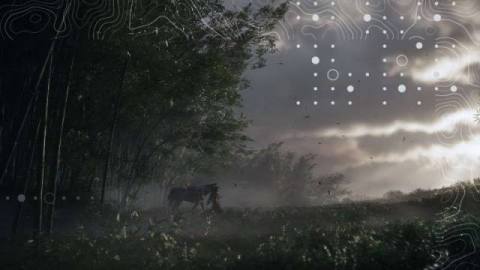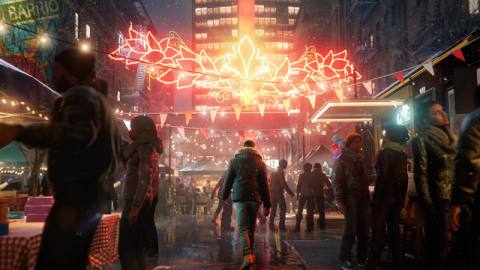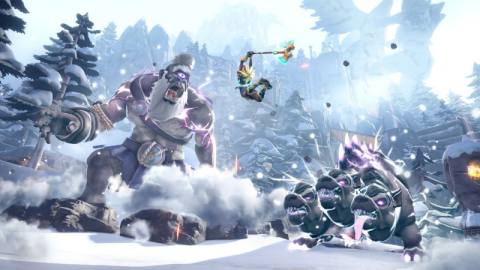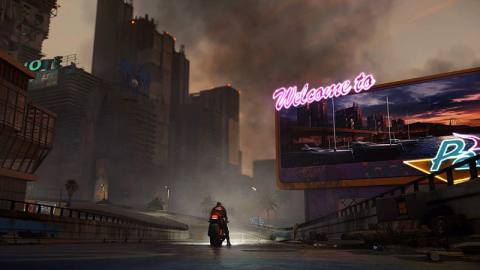
Video games are constantly getting more ambitious, whether it’s from advances in technology offering new possibilities or developers building on past innovations. One area that keeps flourishing is open-world design. Players gladly immerse themselves in virtual environments for hours on end, uncovering every possible facet and secret. But keeping players entertained for the long haul isn’t as simple as randomly filling the map with various knick-knacks and sidequests. Developers constantly have to find new and interesting ways to keep the journey through these massive landscapes exciting, while also making them feel like living and breathing entities. In these vast locales, myriad activities provide fun diversions, NPCs live out full lives, and intriguing discoveries are around every bend.
Everyone can remember their favorite world to explore, but what goes into building these vistas that slowly sprawl out before you? We were curious about the process behind these fascinating places and the design decisions that bring them to life. To learn more about this intense undertaking, we chatted with several developers from award-winning studios such as Ubisoft Montreal and Quebec, Sucker Punch, Insomniac Games, and CD Projekt Red, to see what goes into these worlds that we voluntarily lose ourselves in.
Setting The Stage
Like most endeavors, there isn’t a right or wrong approach to building a virtual world, but the setting does influence the structure, activities, and everything else. When working on the Assassin’s Creed series, Ubisoft takes into account the historical time period and real-world locations, while CD Projekt Red referenced Mike Pondsmith’s pen-and-paper-RPG source material when deciding on locations and districts for Cyberpunk 2077. Other games, like Immortals Fenyx Rising, Ubisoft Quebec’s lighthearted take on Greek mythology, embrace the creative freedom that comes with a fantastical setting. All developers have different rules and philosophies about how far they’re willing to go in terms of realism – taking liberties and making concessions in the name of making a game more fun.
 Assassin’s Creed Valhalla
Assassin’s Creed ValhallaFor Assassin’s Creed Valhalla, level design director Philippe Bergeron said the team had one goal: “[We] want to make sure that [the players] get the greatest hits of being a Viking.” This meant identifying the iconic landmarks, characters, and historical events before dropping them into a geographical map. “We took a top-down view of England,” Bergeron says. “We knew for sure we needed to have Stonehenge and London. We also knew we needed to probably have York; it was like one of the biggest port towns back then … and those White Cliffs of Dover, like on the southern edge of the map.” In the end, Ubisoft Montreal decided to give each territory its own narrative arc, which would introduce you to significant places and figures through the main plot, but also hold its share of environmental storytelling to give each area its own flavor and feel.
You can’t play through Sucker Punch’s Ghost of Tsushima without noticing its serene beauty and striking locales. The team certainly did a lot of research into Japan and took inspiration from Akira Kurosawa films for its samurai tale, but it also wasn’t afraid to punch things up. Sucker Punch took some of the most interesting pockets of the real-world island of Tsushima and expanded them to make its entire map look like the kinds of places that would show up in someone’s Instagram feed. For instance, take the Golden Forest; instead of having every type of tree that actually grows there, the team focused on using orange and yellow hues for the trees. “You can see it from across the island; it definitely stands out,” says art and creative director Jason Connell. “It’s not technically realistic, but it isn’t not realistic either. Those are ginkgo trees, and trees like that do grow in that area. So it’s got enough plausible reality.”
 Marvel’s Spider-Man: Miles Morales
Marvel’s Spider-Man: Miles MoralesInsomniac Games had one rightfully important feature drive how it built the world for its Spider-Man titles: the web-slinging. Having New York as its destination may have given Insomniac a template to work with, but the team had to think about traversal from the perspective of Spider-Man. Miles Morales director Cameron Christian said once the team started asking those questions and figuring out distances and heights, everything started coming together. “There was a lot of exploration early on, like how fast is our Spider-Man swinging?” Christian recalls. “And we started figuring out, well, for every two swings, we want him to pass one large building … and we started to get ideas for metrics and scale and size … We played a lot to determine, where do we exaggerate heights to just make it interesting to swing across the city?”
For CD Projekt Red, narrative reigns supreme, and it tucks away certain threads within its worlds to pique your curiosity. In Cyberpunk 2077, the team used fixers and gigs to introduce you to the issues of the world. For instance, Regina represented the district of Watson and her gigs were an opportunity to learn about Night City’s social issues, like cyberpsychosis among veterans. “We try to get gamers used to the fact that there is a story behind every corner and behind every player-activity in the world,” says open-world director Bartosz Ochman. “These small narrative bites are interconnected with each other, sometimes like a spider’s web, sometimes like Matryoshka dolls. You can consume them one by one, but if you go deeper into the stories behind them, you will see that they are part of the bigger picture.”
Revealing The World
Once a player steps into a world, it’s up to them to explore it and make discoveries. Throughout the years, developers have had many ways of providing indicators and icons for everything from side quests to minigames to treasure. Some games let you see the map and everything it offers all at once, others slowly reveal themselves, requiring you to visit a place or take down an outpost to see an area’s offerings. Some gamers love having direction and a list of things to do before them, checking off one task after the next. Others love making their own discoveries, feeling more rewarded having stumbled upon gold or secrets. Developers are constantly experimenting with the best ways to unveil the map to players, and it’s been fascinating to see the different approaches and how they worked for different experiences.
One of the more unique ways to find your way was recently done in Ghost of Tsushima, which had you following the wind to your desired destination on the map. Surprisingly enough, Sucker Punch didn’t always have a guiding gust in the game, initially opting for a standard, minimal compass to follow. “What we ended up finding [was] a lot of people just stare at the compass or icons,” Connell says. “[The wind] points you in a direction, but instead of looking up at the top of the screen … you ended up looking at the world. You are more immersed, but it’s giving you the same amount of information.”
Sucker Punch took a minimalist approach to the information it put on the map for good reason; it created a breathtaking world, and the team wanted to keep you in it. Whether it was simply providing a question mark as a hint to an area you should explore or showing the rewards upfront to entice you toward a quest, when you looked at the map, Connell said the team wanted it to be as simple and easy to use as possible so you got right back to the game. “The goal has to be: How can we keep you in the game world as much as possible?” Connell says.
Another challenge was figuring out the right amount of content density for a world that at times could be more contemplative. “We didn’t want it to be like, ‘Every 10 seconds there’s something happening,’ but for Ghost of Tsushima, it couldn’t be every three minutes – that’s too long,” Connell says. “We want people to be satiated in their exploration and feel rewarded for that minute or two or 30 seconds of just going off in a direction.” Speaking of those aforementioned question marks, Connell said they were a late addition because people wanted some direction toward discoveries, but the team didn’t want to show its entire hand.
 Immortals Fenyx Rising
Immortals Fenyx RisingThat’s the difficult part. Everyone has their own preferences in how they make discoveries and how much guidance they want. In Immortals Fenyx Rising, you have the farsight ability, which allows you to identify objects and activities in the world and reveal them on the map. Director Scott Phillips said the team tweaked how powerful this tool would be right up until the game went gold. “I feel like with farsight, we [didn’t exactly] nail what I wanted to get,” he says. “But we needed to make sure that people felt that the world had enough to offer them – that they continued to engage with it. I think where we ended is a bit too easy.”
Assassin’s Creed Valhalla changed up how the series categorized things, providing different colors to indicate what might await you: wealth (gold), mysteries (blue), artifacts (white). “That was sort of to play with the notion of mystery,” Bergeron says. “In the past, we would say, ‘This is the blacksmith, this is a tomb, and this is a type of collectible.’ Basically, it becomes a chore of ‘I need to collect all the gems’ or ‘I need to collect all the blacksmiths.’ We were removing that sort of identifier. It’s like a Kinder egg. You’re excited to open up that chocolate egg and see what toy is gonna be inside.”
This aura of mystery also extends to the addition of World Events, special side quests you have to seek out before they appear on the map. These quickly won over fans due to the unique tasks and stories they add to your Assassin’s Creed Valhalla journey, getting as silly as finding viper eggs so a woman can cut a nasty fart or being as heartfelt as shooting down a leaf to help a little girl move on with her life.
Bergeron compares the hidden World Events to the ambiguous question marks that dotted the map in The Witcher 3: Wild Hunt. “You didn’t know what it’s going to be, but you knew it was authored content and it was going to be fun,” he says. “You trusted the developer to have put thought, effort, and love into it.” It also allowed the team to add some levity to Eivor’s adventure and not always focus on the undeniably violent and dark parts of the Viking era. “World Events sort of permitted us to see a different facet of [the Viking lifestyle], portray Eivor’s personality in a different light alongside the people and how they live through all this. It gave us a bit more creative freedom than some of the more earnest stories would have.”
The Rules Of Engagement
Developers spend their time crafting content, so it’s no surprise that they think just as much about ways to draw players toward it. In Immortals Fenyx Rising, Ubisoft Quebec wanted things in the distance to catch your eye and compel you to seek them out. In many cases, environmental cues were used to highlight certain points of interest. “Rather than relying on the HUD as much, we would try to make those things visible in the world and use more glows and sparkles at night,” Phillips says. “We’d highlight or put giant whirlwinds around things that would really call your attention just visually.”
Most developers consider the main quest and your path through it when deciding where to place things. “We want to make sure that not only the location where the quest takes place maximizes the space, but also the trajectory that the player is probably going to be taking,” Bergeron says. “If I think about where a quest ended and where the next quest starts, what’s in between if I draw a straight line? That’s probably where most players are going to go. We’ll draw a bubble of the general environment and make sure that you’re going through some of our ‘greatest hits’ of that territory and sort of tease you as you’re going towards your next location. It’s like, ‘Oh, wait, I see something over there!’ And then you go off track to see that thing.”
Sucker Punch let players see the rewards, like a cool fire-covered sword, for completing “mythic” quests in Ghost of Tsushima as a way to entice them. “Rewards became a strategy for dangling the carrot,” Connell says. “And then the journey was the cool 2D cutscene you get about the lore of the mission, finding out what happened, and the epic duel at the end. Then the excitement is no longer about a sword (even though that’s a nice thing at the end), but it’s [over] the cool character you met along the way, the mystery, the curse, or whatever the mission presented. I would rather give you the easy, fun, and mechanical thing up front and then saturate you in a 30-to- 45-minute-long mission with a different type of storytelling and let that be the thing that stands out.”
Of course, it’s important to note different people are attracted to different things, and while most players aren’t completionists, you still want to keep them in for the long haul. “Variety and quality are key here in keeping the player interested; we don’t want players to feel like there is ‘A content’ to play, and these are part of the ‘B content,” says CD Projekt Red senior level designer Miles Tost. This also comes down to your reward for exploring; CD Projekt Red loves to leave breadcrumbs to follow that can often be as grand as opening a new questline, providing a legendary weapon, or even spotting a cameo from Hideo Kojima. “Small pieces of loot are actually hidden throughout the city without being outright mapped out to players,” adds Ochman. “This is in contrast to The Witcher, where almost every treasure chest was marked on the map itself. It was a deliberate change, and we treat these as the ultimate reward for the most stubborn of urban explorers.”
 Cyberpunk 2077
Cyberpunk 2077Insomniac stuck by what Christian calls the studio’s number-one philosophy to get you noticing things: “It just needs to be fun to move around.” While swinging in Spider-Man, crimes would emergently occur, Sable outposts could be seen in the distance, and special landmarks like the Avengers Tower would beckon you. When the movement feels that good, why not have it lead you to the content, which had everything from collectibles to underground hideouts?
Truth be told, more thought and care go into distributing the content in a game than we realize. Sometimes, it’s as simple as the density of the area playing into where things end up, e.g., a city would have more to do than a rural area. Other times, artists collaborate with quest designers, letting them know about places or landscapes they’ve built that are just begging for a quest. And sometimes small variations in things like time of day or gameplay level can alter what’s available. “I can say that, for us, finding the right density of content and how to place it is more than simply throwing stuff onto a map and seeing what sticks,” Tost says of CD Projekt Red. “It’s a very meticulous process, which we spend a lot of time and thought on. This becomes clearer when you realize that part of the [Cyberpunk 2077] content in the city isn’t fully static, meaning some activities appear only during a certain time of day or after other conditions, like reaching a certain Street Cred level are met.”
 Assassin’s Creed Valhalla
Assassin’s Creed ValhallaA Bright Future
We’ve just entered a new era of console gaming with the PS5 and Xbox Series X/S. With new tech and an eye toward innovation, developers are already pondering how open-world games will evolve. “The future of open-world games … I think it’s a great time to ask that question,” Connell says. “The most important part is embracing the question, and so that’s where I’m at. And I think that a lot of people are thinking about it, whether it’s designers, artists, gamers, or YouTubers. I like this question, because Ghost of Tsushima is so much about what a lot of people enjoy about exploration; a huge part of it is just about enjoying the world. [I’m] embracing the stuff that went well with it. Freedom and exploration in video games are tough, and I think it does pay off and people enjoy it.”
After working on Cyberpunk 2077, Ochman says he started thinking about verticality and how it will play into the future. “I think the imposing scale added by a sense of verticality adds a lot to immersion, especially when you’re on foot and taking in the city from the ground,” he says. “And even now, I can see places where we could have taken even more advantage of this in Cyberpunk 2077. There’s a lot that open-world games could do with verticality, including linking it to more dynamic quests, or tying it closer to the narrative. It’s a pretty exciting prospect.”
Throw in the new consoles’ SSDs making load times almost obsolete and there’s a lot of potential, such as transitioning between environments instantly for more variety and epic encounters. “Anytime you need fast travel, being able to just do it instantly is a huge game-changer,” Phillips says. “Beyond that, I think everything is just a sort of a continuous increase in quality. And the more the world is well-realized and feels like a real place, I think the better off all the games will be – especially seeing as every one or two years, there’s some amazing new thing that someone does that then everyone learns from. We are constantly growing as an industry.”
This article originally appeared in Issue 334 of Game Informer.
